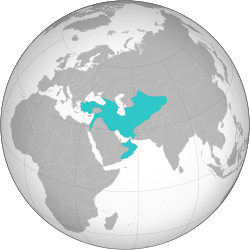
Back Seldjoekse Ryk Afrikaans الدولة السلجوقية Arabic سلاجقه ARZ Imperiu selyúcida AST Səlcuqlular Azerbaijani بؤیوک سلجوقلو ایمپیراتورلوغو AZB Бөйөк Сәлжүк империяһы Bashkir Вялікая Сельджукская імперыя Byelorussian Сэльджукі BE-TARASK Селджуци Bulgarian
Seljuk Raya Büyük Selçuklu Devleti دولت سلجوقیان Dawlat-i Saljūqiān | |||||||||||||||||||||||||||||||||
|---|---|---|---|---|---|---|---|---|---|---|---|---|---|---|---|---|---|---|---|---|---|---|---|---|---|---|---|---|---|---|---|---|---|
| 1037–1194 | |||||||||||||||||||||||||||||||||
 Kekaisaran Seljuk Raya tahun 1092. | |||||||||||||||||||||||||||||||||
 Wilayah terluas dibawah kekuasaan Malik Shah I | |||||||||||||||||||||||||||||||||
| Ibu kota | Nishapur (1037–1043) Rey (1043–1051) Isfahan (1051–1118) Hamadan, Ibukota barat (1118–1194) Merv, ibukota timur (1118–1153) | ||||||||||||||||||||||||||||||||
| Bahasa yang umum digunakan | |||||||||||||||||||||||||||||||||
| Pemerintahan | Monarki | ||||||||||||||||||||||||||||||||
| Sultan atau Shah | |||||||||||||||||||||||||||||||||
• 1037–1063 | Toghrul I | ||||||||||||||||||||||||||||||||
• 1176–1194 | Toghrul III [5][6] | ||||||||||||||||||||||||||||||||
| Sejarah | |||||||||||||||||||||||||||||||||
• Tughril mendirikan sistem negara | 1037 | ||||||||||||||||||||||||||||||||
• Diganti oleh Kekaisaran Khwarezmia[7] | 1194 | ||||||||||||||||||||||||||||||||
| Luas | |||||||||||||||||||||||||||||||||
| 1080 est. | 3.900.000 km2 (1.500.000 sq mi) | ||||||||||||||||||||||||||||||||
| |||||||||||||||||||||||||||||||||
| Sekarang bagian dari | |||||||||||||||||||||||||||||||||
Peringatan: Page using Template:Infobox country with unknown parameter "continent" (pesan ini hanya ditampilkan dalam pratinjau).
Peringatan: Page using Template:Infobox country with unknown parameter "region" (pesan ini hanya ditampilkan dalam pratinjau).
Bagian dari seri mengenai |
|---|
| Sejarah Iran |
 |
Kekaisaran Seljuk Raya atau Kekaisaran Seljuk Agung adalah imperium Islam Sunni abad pertengahan yang pernah menguasai wilayah dari Hindu Kush sampai Anatolia timur dan dari Asia Tengah sampai Teluk Persia. Dari tempat awal mereka di Laut Aral, Seljuk bergerak pertama ke Khorasan dan lalu ke Persia daratan sebelum menguasai Anatolia timur. Kekaisaran ini didirikan oleh Dinasti Seljuk.
- ^ a b Savory, R. M. and Roger Savory, Introduction to Islamic civilisation, (Cambridge University Press, 1976 ), 82.
- ^ Black, Edwin, Banking on Baghdad: inside Iraq's 7,000-year history of war, profit and conflict, (John Wiley and sons, 2004), 38.
- ^ a b c C.E. Bosworth, "Turkish Expansion towards the west" in UNESCO HISTORY OF HUMANITY, Volume IV, titled "From the Seventh to the Sixteenth Century", UNESCO Publishing / Routledge, p. 391: "While the Arabic language retained its primacy in such spheres as law, theology and science, the culture of the Seljuk court and secular literature within the sultanate became largely Persianized; this is seen in the early adoption of Persian epic names by the Seljuk rulers (Qubād, Kay Khusraw and so on) and in the use of Persian as a literary language (Turkish must have been essentially a vehicle for everyday speech at this time)
- ^ Concise encyclopedia of languages of the world, Ed. Keith Brown, Sarah Ogilvie, (Elsevier Ltd., 2009), 1110;Oghuz Turkic is first represented by Old Anatolian Turkish which was a subordinate written medium until the end of the Seljuk rule.".
- ^ A New General Biographical Dictionary, Vol.2, Ed. Hugh James Rose, (London, 1853), 214.
- ^ Grousset, Rene, The Empire of the Steppes, (New Brunswick:Rutgers University Press, 1988), 167.
- ^ Grousset, Rene, The Empire of the Steppes, (New Brunswick:Rutgers University Press, 1988),159,161; "In 1194, Togrul III would succumb to the onslaught of the Khwarizmian Turks, who were destined at last to succeed the Seljuks to the empire of the Middle East."



